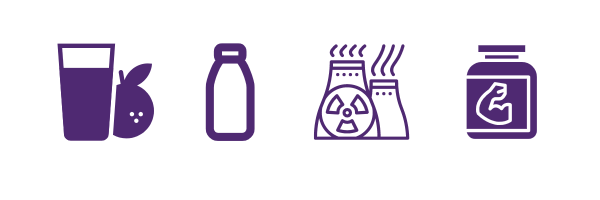Understanding commodities
In our lives, there are certain resources that are very important for us: we use them in food, machinery, work, etc. These natural resources are among the most basic elements of the global economy. And they are called commodities.
What are commodities? When we get a sandwich in the morning for breakfast, we are basically eating the commodities. And here’s what this means: wheat - which is used to make bread, - and cow’s milk - which is used to make butter - are both commodities.
Therefore, a commodity is a basic good, the most elementary resource that humans can get from nature. And while they are mostly used for regular purposes like refilling gas in cars, manufacturing those cars, etc., commodities can also be used in a financial exchange.
Commodity trading basics
The strategy people use to trade commodities is pretty much the same they use for other securities. For example, when a trader wants to trade oil, they usually buy this commodity when its price is low and starts to increase. And when the oil price reaches the desired point and slowly starts to decline, they sell it. The difference between the high selling price and the low buying price will produce a payout.
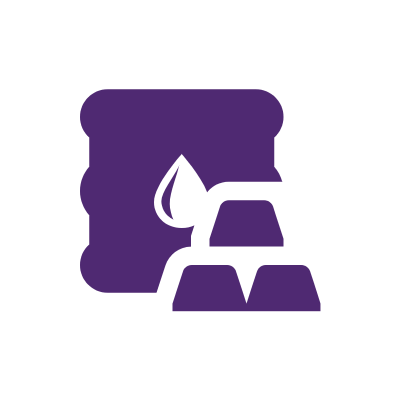
There are various ways of commodity trading online or offline. The most direct way to do that is to make a future contract and buy a commodity at a certain price when it is delivered in the future. However, there are indirect ways of trading such as purchasing stocks in companies that are based on commodities and their prices, buying mutual or index funds that also invest in many such companies at once, and many more.
Commodities trading at Axiory
Axiory provides a diverse range of trading opportunities, including precious metals and energies. Let’s delve into a comprehensive exploration of each financial instrument, unraveling their distinctive features and characteristics. It should be mentioned that there are 4 different account types to choose from and trading conditions are different on each.
Precious Metals trading at Axiory
Engaging in the trading of precious metals through Contracts for Difference (CFDs) has gained popularity among investors as an avenue for speculating on price fluctuations without the necessity of owning the tangible metal assets. There are various benefits that come with trading Metals as CFDs over physical metal trading. Here are some key benefits:
- Leverage: traders can use leverage to increase their purchasing power and control a larger position size.
- Ability to go short: CFDs enable traders to go short in falling markets and make money. This option is not available when trading physical assets.
- Higher liquidity: CFDs have much higher liquidity than their physical counterparts. Meaning, spreads (difference between buying and selling price) are narrow, and it’s easier to trade the assets.
With Axiory, traders can invest in the most popular precious metals such as: Gold, Silver, Platinum, and Palladium. And these precious metals are traded against the US Dollar.
Gold vs US Dollar (XAUUSD)
Maximum available leverage for gold trading is 100:1. Nano account and Tera account holders are charged with $6 commissions, and there are no commissions for other accounts. Average spreads for XAU/USD are following:
- Nano account: 0.15 pips
- Standard account: 0.35 pips
- Max account: 0.42 pips
- Tera account: 0.15 pips
Margin call/Stop-out levels for all account types are, 50/20% respectively.
Silver vs US Dollar (XAGUSD)
Similarly to gold trading, max available leverage is 100:1, Margin call and stop out levels are 50% and 20% and commissions are $6 for Naono and Tera accounts. Average spreads are:
- Nano account: 0.012 pips
- Standard account: 0.032 pips
- Max account: 0.039 pips
- Tera account: 0.012 pips
Platinum vs US Dollar (XPTUSD)
Maximum available leverage to trade Platinum is 20:1. Margin/Stop levels are 50/20%, and the commission is the same $6 for Nano and Tera accounts. Let’s check average spreads:
- Nano account: 1.59 pips
- Standard account: 1.59 pips
- Max account: 1.69 pips
- Tera account: 1.59 pips
Palladium vs US Dollar (XPDUSD)
Similarly to Platinum, max. Available leverage is 20:1. And there's a $6 commission on Nano and Tera accounts. Average spreads:
- Nano account: 5.36 pips
- Standard account: 5.36 pips
- Max account: 5.46 pips
- Tera account: 5.36 pips
Energies trading at Axiory
Axiory offers popular energies as CFDs for trading such as: Natural Gas, Brent oil, and Crude oil. Maximum available leverage is 20:1, and the commissions are the same $6 for Nano and Tera accounts. There are no commissions for Standard and Max account holders. Instead, trading fees are included in spreads. Margin call/Stop put levels are: 50/20.
Different commodity types
Commodities fall into one of two categories: hard or soft. In turn, hard and soft commodities have individual elements, namely:
Hard:
Soft:
- Livestock and meat
- Agriculture
Let’s take a look at what each of these categories include and their specifications.
Hard commodities
This list of commodities includes the resources that are typically received from the ground in a process of mining (metals) or extraction (energy). In short, they are natural resources.
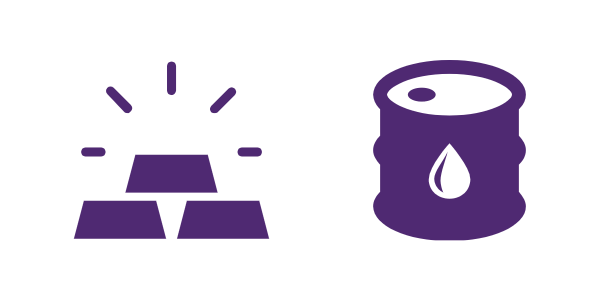
The metal sub-category includes precious materials such as gold, silver, platinum, as well as other metals - iron, aluminum, copper, etc. The world economy is heavily dependent on gold because of its stability, especially during the times of an economic slowdown: when regular currencies become unstable, individuals and corporations tend to invest in gold to maintain the long-term value of their property.
Then, there is the energy sub-category. It combines natural gas and oil reserves. As we previously mentioned, these resources can be extracted from the ground. Natural gas is the main resource used for residential and commercial purposes - that is, for heating our homes and commercial buildings.
Oil - the most important commodity
On the commodity market, and in the sub-category of energies, crude oil rightfully takes the number one position when it comes to its influence on the global economy and politics. For one, it supplies almost half of the global energy needs; for another, it is the most-traded commodity on the market.
And it is pretty easy to understand why it is considered that way: we drive our cars by refilling our tanks with gasoline, we receive orders from overseas by ships that also run on fuel, we travel on planes that run on jet fuel. But apart from fueling the machines, crude oil is also used to make plastic, which can be found in almost everything we own.
Soft commodities in trading
Soft commodities, unlike the hard ones, need additional work to be created first and then received. Here’s what this means: when we want to get wheat to bake bread, we first need to plant the wheat seeds, cultivate the land, and then reap the harvest. The same is true for “living commodities”- be it cattle or other domesticated animals. In short, this sub-category combines agricultural production and livestock
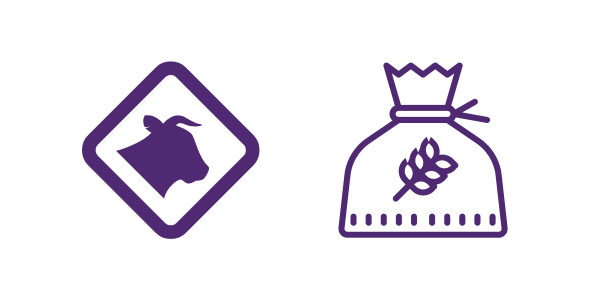
While agricultural production is the basis of every strong economy, some countries go further and use these commodities as the main exporting economic resource. For example, avocado export for Columbia or cocoa beans for Ghana are the main sources of income for these countries.
Factors that influence commodity prices
Supply and demand
When it comes to commodity trading prices, the most fundamental factors that influence them are supply and demand forces. Supply is the amount of a commodity provided to the market; demand is the amount of a commodity that people actually want to buy.
According to basic economics, if the commodity supply is higher than the demand, the prices will go down. And if the demand is higher than the supply, the prices will go up. The same is true for the opposite cases.
Traders can find information about the supply and demand of commodities via private research firms or government departments. For example, the US Department of Agriculture makes the World Agriculture Supply Demand Estimate (WASDE) report every month which shows what the supply and demand levels are on agricultural commodities.
Other important factors
Another very important influencing factor is the US dollar. Since the USD is the main currency used for most global economic transactions, its stability or instability also makes commodity prices stable or unstable. For example, if the currency is strong, the price of oil will be lower as well.
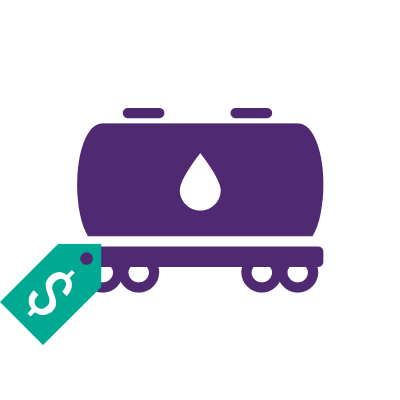
There are also other factors like inflation and GDP (gross domestic product). Inflation means the prices on goods and services are increasing, which also means the commodity prices are on the rise too. In terms of deflation, prices are going down on commodities and other goods/services.
As for the GDP, if it is high, demand will be higher on commodities because the economy is expanding. And if it’s low, there will be lower demand in commodities because people have fewer resources to actually buy them.
Other small details about commodities
What is Forex commodity trading?
When talking about commodity meaning and how this asset works, we mentioned that commodities and Forex pairs are completely different assets. While this is definitely true, the two assets are still connected to each other.
When Forex brokers offer currency pairs to their traders, many of them also include commodities in their trading package. This means that traders can exchange not only
currencies but also oil, gold, crops, and other commodities.
Besides, as we have mentioned above, prices on commodities are expressed in currencies like the US dollar. Therefore, the developments in either of these markets can have a big influence on the other.
Strange ways of trading commodities
Now, the most popular commodities used for trading are oil, gas, gold, silver, etc.; however, there are other somewhat strange ways of commodity trading, meaning that they aren’t as usual as the above-mentioned commodities. Let’s see some of the most untraditional ones.
Frozen orange juice futures: under the symbol OJ, frozen orange juice futures are one of the weirdest trading commodities on the market. The OJ can be traded on the Intercontinental Exchange (ICE). One futures contract contains 15,000 pounds of frozen orange juice and can reach 20,000 contracts daily.
Non-fat dry milk: this is also a strange commodity to trade. Under the symbol GNF, non-fat dry milk can be exchanged on the Chicago Mercantile Exchange (CME), where one futures contract contains 44,000 pounds of milk. On the CME, the daily traded volume of GNF is around 10-200 contracts.
There are other unconventional commodities like emission allowance futures, uranium, dry whey, and many more.
